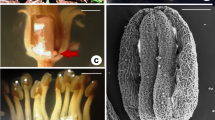Abstract
Tetrapedia diversipes and other Apidae (Anthophoridae) may be deceived by floral similarities between Malpighiaceae and Orchidaceae of the Oncidiinae subtribe. The latter do not usually exudate floral oils. Thus, visitors may pollinate the flowers in a deceit/food/pollination syndrome. We studied the chemical compositions of Byrsonima intermedia (Malpighiaceae) floral oil and T. diversipes (Anthophoridae) cell provisions. From B. intermedia floral oil, we isolated a novel fatty acid (3R, 7R)-3,7-diacetoxy-docosanoic acid, here named byrsonic acid, and from T. diversipes cell provisions we isolated two novel fatty acid derivatives 3,7-dihydroxy-eicosanoic acid and 3,7-dihydroxy-docosanoic acid, here named tetrapedic acids A and B, respectively. The three fatty acid derivatives have common features: possess long chains (20 or 22 carbon atoms) with no double bond and either hydroxy or acetoxy groups at carbons 3 and 7. This characteristic was also encountered in the fatty acid moiety of oncidinol (2S, 3′R, 7′R)-1-acetyl-2-[3′, 7′-diacetoxyeicosanyl)-glycerol, a major floral oil constituent of several Oncidiinae species (Orchidaceae). Thus, both tetrapedic A (C20) and B (C22) could be the biotransformation products of oncidinol and byrsonic acid by T. diversipes hydrolases. These are the chemical clues for bee visitation and oil collecting from both plant species. The results indicate that the deceit/pollination syndrome should not be applied to all Oncidiinae flowers.



Similar content being viewed by others
References
Alves-dos-Santos, I., Melo, G. A. R., and Rozen, J. G. 2002. Biology and immature stages of the bee tribe Tetrapediini (Hymenoptera:Apidae). Am. Mus. Novit. 337:1–45.
Dale, J. A. and Mosher, H. S. 1973. Nuclear Magnetic resonance enantiomer reagents. Configurational correlation via nuclear magnetic resonance chemical shifts of diastereomeric mandelate, O-methylmandelate and α-methoxy-a-trifluoromethylphenylacetate (MTPA) esters. J. Am. Chem. Soc. 95:512–519.
Duddeck, H. 1986. Substituent effects on 13C chemical shifts in aliphatic molecule systems. Dependence on constitution and stereochemistry. Topics in Stereochemistry. 16:219–234.
Neff, J. L. and Simpson, B. B. 1981. Oil-collecting structures in the Anthophoridae (Hymenoptera): morphology, function and use in systematics. J. Kans. Entomol. Soc. 54:95–123.
Nierenberg, L. 1972. The mechanism for the maintenance of species integrity in sympatrically occurring equitant Oncidiums in the Caribbean. Am. Orchid Soc. Bull. 41:873–882.
Ohtani, I., Kusumi, T., Kashman, Y., and Kakisawa, H. 1991. A new aspect of an advanced Mosher’s Method. Absolute configuration of marine triterpene Sipholenol-A. J. Am. Chem. Soc. 113:4092–4096.
Reis, M. G. 2005. Caracteres químicos em estudos de filogenia e biologia de polinização de Oncidiinae (Orchidadeceae). PhD dissertation. UNICAMP. Campinas.
Reis M. G., Faria, A. D., Bittrich, V., Amaral, M. C. E., and Marsaioli, A. J. 2000. The chemistry of flower rewards—Oncidium (Orchidaceae). J. Braz. Chem. Soc. 11:600–608.
Reis M. G., Faria, A. D., Amaral, M. C. E., and Marsaioli, A. J. 2003. Oncidinol—a novel diacylglycerol from Ornithophora radicans Barb. Rodr. (Orchidaceae) floral oil. Tetrahedron Lett. 44:8519–8523.
Reis M. G., Singer, R. B. Gonçalves, R., Marsaioli, A. J. 2006. The chemical composition of the floral oils of Phymatidium delicatulum and Phymatidium tillandsioides (Orchidaceae). Natural Product Communication 1:757–761.
Seigler, D., Simpson, B. B., Martin, C., and Neff, J. L. 1978. Free 3-acetoxy fatty acids in glands of Krameria species. Phytochemistry. 17:995–996.
Sigrist, M. R., and Sazima, M. 2004. Pollination and reproductive biology of twelve species of neotropical Malpighiaceae: Stigma morphologya and its implications for the breeding system. Ann. Bot. 94:33–41.
Silvera, K. 2002. Adaptive Radiation of Oil-Reward Compounds among Neotropical Orchid Species (Oncidiinae). Master of Science Thesis. University of Florida.
Singer, R. B. 2003. Orchid pollination: recent developments from Brazil. Lankesteriana 7:111–114.
Steiner, K. E. 1998. The evolution of beetle pollination in South African orchid. Am. J. Bot. 85:1180–1193.
Sullivan, G. R., Dale, J. A., and Mosher, H. S. 1973. Correlation of configuration and 19F chemical shifts of α-methoxy-α-trifluoromethylacetate derivatives. J. Org. Chem. 38:2143–2147.
Vinson, S. B., Williams, H. J., Frankie, G. W., and Shrum, G. 1997. Floral lipid chemistry of Byrsonima crassifolia (Malpigheaceae) and use of floral lipids by Centris bees (Hymenoptera: Apidae). Biotropica. 29:76–83.
Vinson, S. B., Frankie, G. W., and Williams, H. J. 2006. Nest liquid resources of several cavity nesting bees in the genus Centris and the identification of preservative, levulinic acid. J. Chem. Ecol. 32:2013–2021.
Vogel, S. 1969. Flowers Offering Fatty Oil Instead of Nectar. XI Proc. Int. Bot. Cong. Abstracts. Seattle, p. 229.
Vogel, S. 1974. Öblumen und Ölsammelnde Bienen. Akad. Wissenschaften Mainz. Wiesbaden: Franz Steiner. 544p
Whitten, M. Pollination Biology of Orchids. 2006. http://hort.ifas.ufl.edu/osc2006/whitten.pdf.
Whitten, W. M., Williams, N. H., and Chase, M. W. 2000. Subtribal and generic relationships of Maxillarieae (Orchidaceae) with emphasis on Stanhopeinae: Combined molecular evidence. Am. J. Bot. 87:1842–1856.
Williams, N. H., Chase, M. W., Fulcher, T., and Whitten, W. M. 2001. Molecular systematics of the Oncidiinae based on evidence from DNA sequence regions: Expanded circumscriptions of Cyrtochilum, Erycina, Otoglossum, and Trichocetrum and a new genus (Orchidaceae). Lindleyana. 16:113–139.
Acknowledgements
The authors are indebted to FAPESP (Fundação de Amparo a Pesquisa do Estado de São Paulo—grants #01/02794-7, #98/07781-6 and #03/06624-4) and CNPq (Conselho Nacional de Desenvolvimento Científico e Tecnologia) for scholarships and financial support. The authors are also grateful to Vera Lúcia Imperatriz Fonseca and Sandra Regina Capelari Naxara of Universidade de São Paulo-USP for the Byrsonima intermedia flowers, and Carol Collins and Volker Bittrich for critical reading and text correction.
Author information
Authors and Affiliations
Corresponding author
Rights and permissions
About this article
Cite this article
Reis, M.G., de Faria, A.D., dos Santos, I.A. et al. Byrsonic Acid—the Clue to Floral Mimicry Involving Oil-Producing Flowers and Oil-Collecting Bees. J Chem Ecol 33, 1421–1429 (2007). https://doi.org/10.1007/s10886-007-9309-y
Received:
Revised:
Accepted:
Published:
Issue Date:
DOI: https://doi.org/10.1007/s10886-007-9309-y




